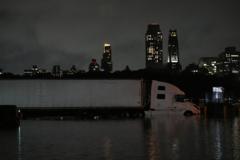On Monday night, heavy rains caused flash flooding in both states, prompting New Jersey Governor Phil Murphy to declare a state of emergency in response to the devastating impacts. In Plainfield, New Jersey, two individuals tragically lost their lives when their vehicle was swept away in floodwaters, as reported by Governor Murphy on Tuesday.
The National Weather Service (NWS) has issued warnings for potential additional storms on Tuesday, with further flooding possible across the northeast, Florida, and the midwestern United States. By Tuesday morning, numerous main roads in New Jersey remained closed due to water accumulation, with subway services in both New York City and New Jersey facing significant delays.
Within just a few hours, parts of New Jersey received over 6 inches (15 cm) of rain, leading to widespread flight delays and cancellations at Newark Liberty International Airport. Rescue operations were necessary in various areas, including one heroic instance in Scotch Plains, where responders used ropes to save a man trapped in his submerged vehicle.
In New York City, flooding severely impacted subway stations, where water cascaded into subway cars, forcing commuters to find higher ground within the vehicles. The city experienced its second-highest hourly rainfall in over 80 years, with a staggering 2 inches falling in just half an hour. Virginia also faced flooding threats, with the cities of Colonial Heights and Petersburg identified as at risk for severe damage, according to the NWS.
While the heaviest rains are reported to be moving east and weakening, authorities urge residents to be cautious and adhere to road closures. This weather event follows a recent tragedy in Texas, where over 130 lives were lost due to flash floods, with many individuals still unaccounted for.
As communities assess the damage and prioritize public safety, the impact of these extreme weather patterns continues to evolve.
The National Weather Service (NWS) has issued warnings for potential additional storms on Tuesday, with further flooding possible across the northeast, Florida, and the midwestern United States. By Tuesday morning, numerous main roads in New Jersey remained closed due to water accumulation, with subway services in both New York City and New Jersey facing significant delays.
Within just a few hours, parts of New Jersey received over 6 inches (15 cm) of rain, leading to widespread flight delays and cancellations at Newark Liberty International Airport. Rescue operations were necessary in various areas, including one heroic instance in Scotch Plains, where responders used ropes to save a man trapped in his submerged vehicle.
In New York City, flooding severely impacted subway stations, where water cascaded into subway cars, forcing commuters to find higher ground within the vehicles. The city experienced its second-highest hourly rainfall in over 80 years, with a staggering 2 inches falling in just half an hour. Virginia also faced flooding threats, with the cities of Colonial Heights and Petersburg identified as at risk for severe damage, according to the NWS.
While the heaviest rains are reported to be moving east and weakening, authorities urge residents to be cautious and adhere to road closures. This weather event follows a recent tragedy in Texas, where over 130 lives were lost due to flash floods, with many individuals still unaccounted for.
As communities assess the damage and prioritize public safety, the impact of these extreme weather patterns continues to evolve.























